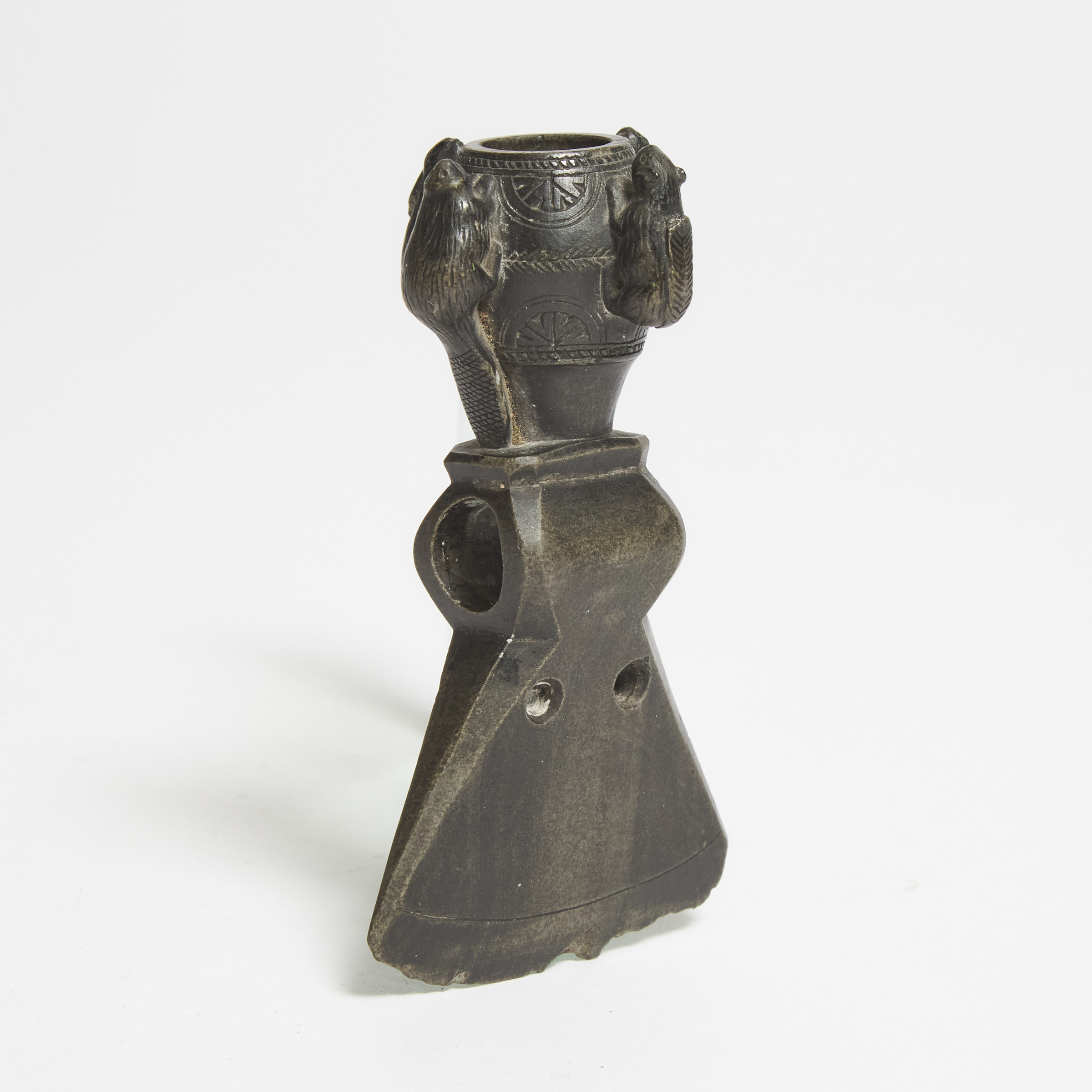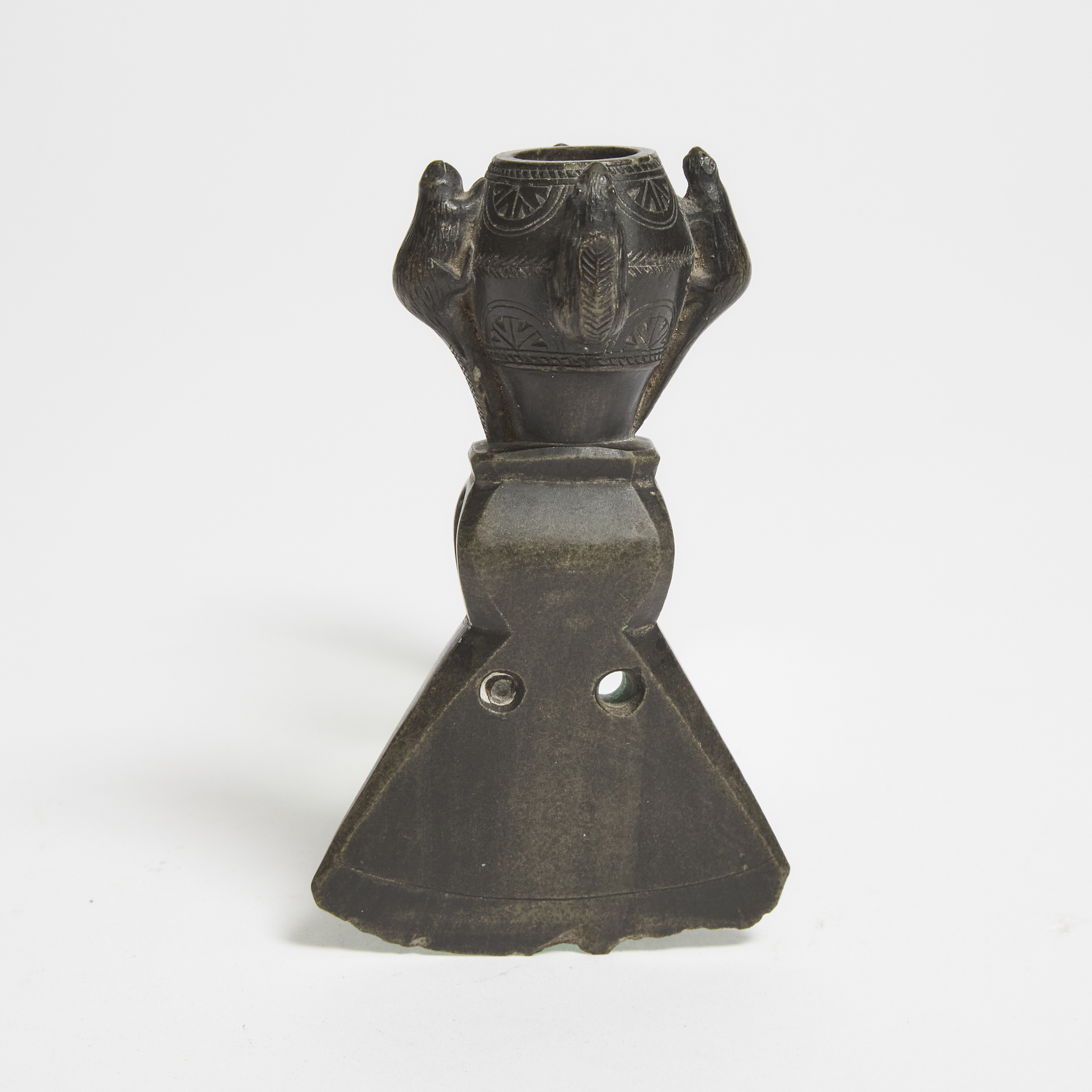Lot 4
Unidentified Mi'kmaq or Wolastoqiyik (Maliseet) Artist

Lot 4 Details
Unidentified Mi'kmaq or Wolastoqiyik (Maliseet) Artist
FIGURAL PIPE BOWL, FIRST HALF OF THE 19TH CENTURY
stone
cask-form bowl atop tomahawk-form base bearing beaver, otter, squirrel, and rabbit effigies
subject 4 x 2.25 x 1.75 in — 10.2 x 5.7 x 4.4 cm
Estimate $7,000-$9,000
Additional Images

Provenance:
Morning Star Gallery, Santa Fe, NM;
Collection of Steven Blevins & Sonja Morawetz, Ontario
Literature:
Robin Langley Sommer, Native American Art, (New York: Smithmark, 1994), 138
Note:
Elaborate and finely carved pipes with incised circular or semi-circular designs and animal figuration began to appear in collections associated primarily with Maritime Canada around the mid 19th century. Several related examples are documented in public and private collections, in addition to publications on historical First Nations art, yet relatively little has been firmly established about this sub-family of pipes.
Typically attributed to the Maliseet or neighbouring Mi'kmaq, all pipes with a vasiform bowl placed centrally atop of a round, square, rectangular, or keel-shaped base have been referred to by collectors as “Micmac pipes” in years past, bringing a lack of clarity to attributions even where the “Micmac” (Mi'kmaq) name may be associated with an example. Both Maliseet and Mi'kmaq peoples used clustered circular motifs in their crafts in the early 19th century and both produced objects for internal consumption and trade with the industriousness that the number of known examples of pipes from this family suggests.
Various readings have been posited on the potential meaning of the figuration on individual examples of the figural pipes closely related to the present example. None of the explanations are applicable across all known examples. The most sensible assertion comes from J.C.H. King, former curator at the British Museum, who notes the animals depicted on this family of pipes (often in fours) are likely of either ritual or economic significance. (1)
The present pipe is unique among known examples for its inclusion of a well-developed and finely shaped tomahawk form under the bowl. Faceted tomahawk heads of the type depicted are perhaps most typically associated with late 18th and early 19th century presentation examples, and possibly alludes to the nature of the present pipe as a gift or object of exchange.
1. J.C.H. King, Smoking Pipes of the North American Indians, (London: British Museum Publications, 1977), 15-16
Related Works:
Joseph D. McGuire, Pipes and Smoking Customs of the American Aborigines, (Washington: U. S. Government Printing Office, 1899), 485, pl. 106
John C. Ewers, Blackfoot Indian Pipes and Pipemaking, (Washington: U. S. Government Printing Office, 1963), bulletin 186, pl. 27
Ralph T. Coe, Sacred Circles: Two Thousand Years of North American Indian Art, (London: Lund Humphries, 1976), 100, pl. 165
John Warnock, Marva Warnock, Clinton Nagy et al, Splendid Heritage: Perspectives on American Indian Art, (Utah: University of Utah Press, 2009), 114, WC8708104
Gaby Pelletier, Mi'kmaq and Maliseet Decorative Traditions (St. John: New Brunswick Museum, 1977), 15
National Museum of the American Indian, Cat. No. 2/9031
Royal Collection Trust, Cat. No. RCIN 84357
National Museums NI, Cat. No. BELUM.C153.1910
The British Museum, Cat. No. Am,Dc.13
The British Museum, Cat. No. Am,Dc.12
Pitt Rivers Museum, University of Oxford, Cat. No. 1886.1.862




